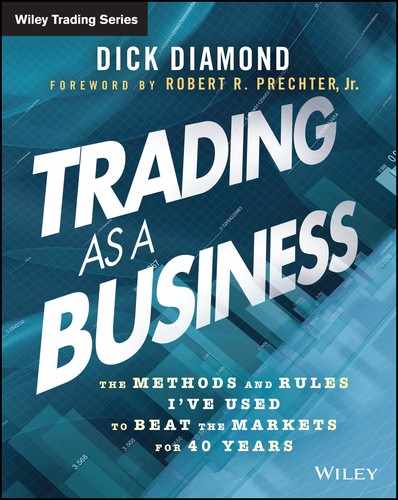Preface
I've been around the trading game for over 40 years. I've seen a lot of traders come and go. But while it's a tough and unforgiving game, it is possible to make a great living from trading. The keys, as I discuss throughout this book, are emotional discipline and risk control.
I've organized this book, Trading as a Business, in much the same way that I teach attendees at my seminar. I recount a little bit about my own history as a trader. I discuss the principles that I use to guide my trading and explain the technical indicators that I use. Finally, I reveal my four trading templates and provide dozens of examples of how I use the templates to place trades.
I would suggest reading the entire book from beginning to end and then returning to Chapter 2, “Emotional Discipline”; Chapter 3, “Principles of Successful Trading”; and Chapters 5 through 8, which discuss trading with four different templates. After you've mastered the material, I suggest you set up the trading templates on your computer and begin analyzing the markets every day using the templates. Just as I do in Chapters 5 through 8, you should try to identify 80/20 trades (trades that will produce a profit four out of five times).
I have taught many traders, and I certainly understand that readers will come to this book with different levels of trading experience and expertise in technical analysis. Many of my most successful students adapted parts of my methods to their preexisting approach and evolved into better traders. Roberto Hernandez, a former student who now teaches with me, uses his own trading template, which incorporates some indicators that I do not use at all. If you're going to modify the templates or use your own template, I would suggest a few things. First, and most importantly, do not rely on a single indicator or even two indicators. The markets are too complex to be reducible to a single indicator at all times. I advocate using three to five indicators in a template and waiting until all the indicators align before putting on a trade. Second, make sure that your template is effective in identifying 80/20 trades. From my experience, it's tough to maintain emotional discipline when your template is wrong almost as much as it is right. Finally, read and reread the chapters on trading principles and make them part of your trading DNA. Trade small, use tight stops, and cultivate emotional discipline.
While it's fine to modify my templates or create your own templates, I believe the majority of traders will be better off using the templates in the book. They are the templates I use in my own trading; I know they work.
As I discuss in the chapter on emotional discipline, it's essential that you feel confident in your trading strategies and your trading rules. A trader without confidence will have a hard time pulling the trigger and will constantly second-guess his/her system and rules. A trader with confidence will consistently follow his/her trading signals, will adhere to his/her trading rules, and will accept with equanimity the occasional loss. Remember, as long as you followed your signals and followed your rules, you made a good trade—regardless of whether it produced a profit or loss.
My goal in this book is to give you all the tools you need to trade successfully and to trade with confidence. If you study the material here and work hard to implement the strategies and rules in the market, there's no reason you can't become a consistently profitable trader.
